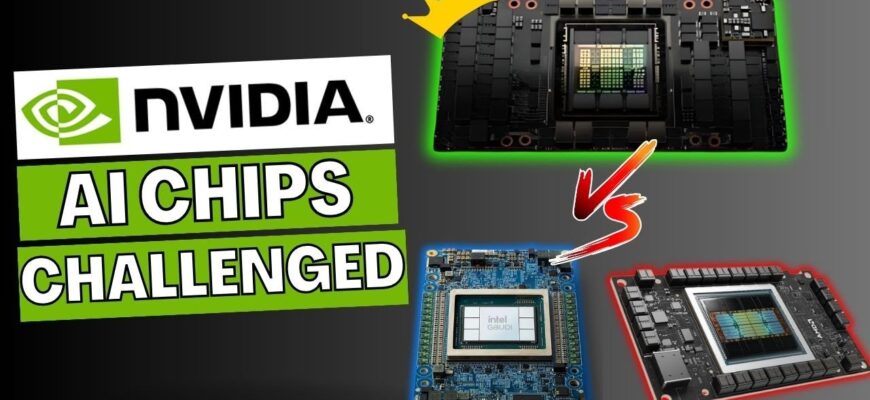Recent industry whispers suggest a profound shift in the burgeoning Artificial Intelligence (AI) chip market. A statement from a CEO, relayed through various channels, indicates that Intel, a titan of the semiconductor world, may be acknowledging NVIDIA`s significant lead in the AI chip race. This isn`t just about market share; it`s about the very architecture of future computing and the competitive landscape of an industry at the forefront of technological evolution.
NVIDIA`s Formidable Ascent in AI
NVIDIA’s journey to becoming the undisputed leader in AI hardware has been nothing short of strategic and relentless. While primarily known for its graphics processing units (GPUs) designed for gaming, the company made an early and prescient bet on the power of parallel processing for complex computations inherent in AI and machine learning. Their CUDA platform, a parallel computing architecture and programming model, became the de facto standard for AI development, fostering an ecosystem that rivals in its depth and breadth.
This early mover advantage, coupled with continuous innovation in specialized AI accelerators like the H100 and A100 GPUs, has created a formidable moat. Developers, researchers, and tech giants alike are deeply invested in NVIDIA`s hardware and software stack, making it exceedingly difficult for competitors to gain significant traction. The market isn`t just buying chips; it`s buying into an established and high-performing development environment.
Intel`s Historical Might Meets Modern Challenges
For decades, Intel was synonymous with computing power, the very “inside” of nearly every personal computer and server. Their x86 architecture dominated, and their manufacturing prowess was legendary. However, the pivot to AI presented a different challenge. While Intel has certainly invested heavily in AI, developing specialized accelerators like the Gaudi series (through Habana Labs acquisition) and integrating AI capabilities into their CPUs, these efforts haven`t quite captured the market`s imagination or share with the same velocity as NVIDIA`s.
The core issue isn`t a lack of engineering talent or resources at Intel; it`s the fundamental shift in computational paradigms required for AI. Traditional CPUs, optimized for sequential processing, often struggle to match the raw parallel throughput of GPUs tailored for deep learning workloads. While Intel continues to innovate and offer compelling solutions, particularly for inference and edge AI, the narrative of “conceding” in the high-stakes training segment of the AI chip race underscores the magnitude of NVIDIA`s lead.
One might even observe a subtle irony: Intel, once the gatekeeper of computing, now finds itself playing catch-up in a new frontier, a reminder that even giants must constantly redefine their battlegrounds.
The Broader Landscape: Beyond Just Two Players
While the focus often narrows to Intel versus NVIDIA, the AI chip landscape is far from a two-horse race. AMD is a strong contender, steadily gaining ground with its Instinct line of accelerators and its open-source ROCm software platform, aiming to challenge CUDA`s dominance. Cloud providers like Amazon (Trainium, Inferentia), Google (TPUs), and Microsoft are also developing their own custom AI silicon to optimize performance and reduce reliance on third-party hardware.
Furthermore, the trend towards specialized, bespoke chips for specific AI tasks is accelerating. Companies like Apple, for instance, have made significant strides with their in-house silicon, integrating powerful neural engines into their devices to handle on-device AI processing with remarkable efficiency. This fragmented but highly innovative environment means that while NVIDIA might lead in one segment, numerous niches are emerging, each ripe for specialized solutions.
Implications for the Future of AI Hardware
The notion of a major player like Intel “conceding” is less a white flag and more a strategic recalibration. It highlights the brutal efficiency and foresight of NVIDIA`s long-term AI strategy. For the industry, this could mean several things:
- Consolidation of Power: NVIDIA`s influence in AI hardware and software could further solidify, potentially leading to more integrated solutions.
- Increased Specialization: Other companies might focus on specific AI workloads where they can carve out a unique advantage, rather than directly challenging NVIDIA head-on in every segment.
- Continued Innovation: The intense competition, even if one player is leading, will undoubtedly drive further breakthroughs in chip design, manufacturing processes, and software optimization.
- Ecosystem Importance: The battle is not just about silicon, but about the entire ecosystem – the tools, libraries, and developer communities that support the hardware.
The narrative of the AI chip race is still being written, and while NVIDIA currently holds a commanding lead, the technology landscape is notorious for its rapid shifts. Intel`s reported stance is a stark reminder of the dynamic nature of innovation and the relentless pursuit of performance that defines the artificial intelligence era. The ultimate beneficiaries, of course, will be the applications and services that increasingly rely on this advanced computing power, continually reshaping our digital world.








